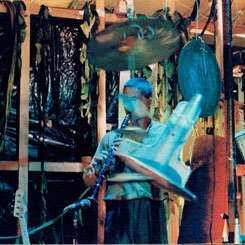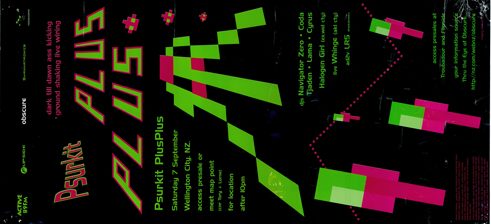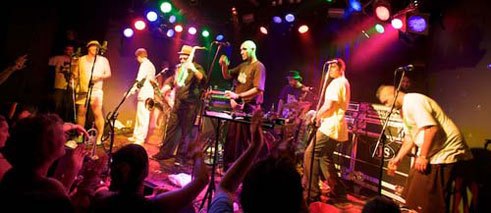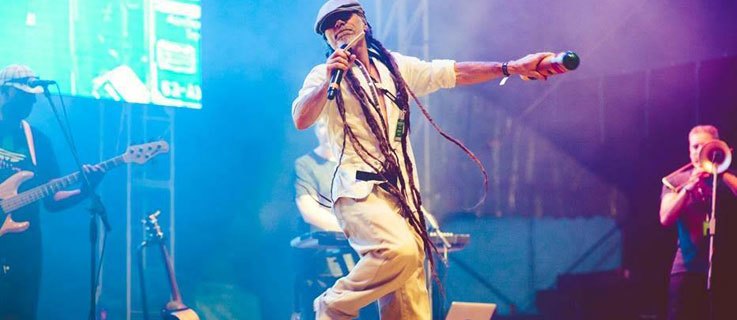Connecting the international strands of dub techno, and seeding the growth of this movement, is the uptake of key technologies in combination with an ability to think outside the machine, to adapt the studio and invent a new sonic landscape.
The bass and the drum become the source of music, the studio becomes an instrument, and bodies are moved by the force of sound systems. Transported to Aotearoa-New Zealand this new way of shifting air meshed with the strong underlying pulse of reggae and a growing underground of musicians experimenting with electronic instruments. Perhaps the first inkling of this future in New Zealand came in the late 1980s when the quasi-industrial experimental sonics of Michael Hodgson, working collectively with Angus McNaughton and others under the moniker Tinnitus, shifted to embrace the sonic density and textural sparsity of dub and techno.
Audio: Tinnitus, Ambient Image
Outside of my own fetishization of imported electronica, this being before the internet made all music accessible (everywhere), two events disrupted my sonic world: Living in central Wellington and on the periphery of various music scenes, it was inevitable that I would end up in the company of musicians and their studios. As it turned out a subterranean corner of my own flat was host to electronic boxes, various drum machines and a nest of wires – the studio of Aotearoan techno pioneer LRS.
 Ashley Turner at the Tinnitus performance in Christchurch, New Year's Eve 1986/7 | © audioculture.co.nz
Ashley Turner at the Tinnitus performance in Christchurch, New Year's Eve 1986/7 | © audioculture.co.nz
The second event came with the arrival of cryptically labelled Basic Channel records, each one a dive into an abyss of bass, an absence of footholds in the dense pulse. Found among them, a trio of Porter Ricks’ 12"s housed a sound suggestive of a sub-aquatic relocation of the techno aesthetic.
Audio: LRS, Proxy
The sounds of Germany and Detroit were no longer so far away, as the poster for Psurkit Plus Plus informed us, "dark till dawn ass kicking ground shaking live wiring" had arrived in Wellington, Aotearoa's capital. A scene rapidly coalesced around a number of individuals whose magic revolved around finding the funk in the machine. As a snapshot of this time, the seminal recording "Skankatronics: Pure Wellingtronica” introduced audiences to a thriving local underground. On this compilation already established artist Jet Jaguar rubbed shoulders with LRS, Oblique and Polarity, all of whom share an approach to music making that does not exclude the grain, the distortion, or the sheer density of sound – sonic texture as the root of dub sensibility had arrived in NZ. This was a new way of making music combined with a different way of appreciating it. The novelty of the warehouse party soon gave way to the appropriation of the bunker, the minimalism of techno maximally amplified to make space into an aural fog, while smoke machines and strobes intensified the disorientation of the senses.
 Poster for Psurkit’s Plus Plus event | © Psurkit
Poster for Psurkit’s Plus Plus event | © Psurkit
Audio: micronism
micronism, constructing space
 © kog.co.nz
© kog.co.nz
These new forms of electronic music were also strongly represented in Auckland, centring around Kog Transmissions, a studio and label established in 1997. Drawing a diverse range of musicians and producers into its fold, including Michael Hodgson, Denver McCarthy and Leyton Glen. Under his Micronism alias, McCarthy was to release what is regarded by some as New Zealand's first techno album, "Inside a Quiet Mind". Conceived of as a journey, the album tracks a cohesive progression over its duration, while flitting between sub-genres and aural textures, while at some points the dense production and glitchy sonics swallow the beat altogether.
Leyton Glen meanwhile found himself split into three identities. Epsilon Blue for straightforward house. rotor+ which revealed an experimental tendency, exploring the peripheries of durational composed electronica. son.sine dived into a deeply contemplative ocean of warm beats. As a remix project, son.sine was also responsible for the deconstruction and re-purposing of numerous tracks by Glen’s contempories, often enhancing the crackle and the space within, pushing hissing details forward in the mix. The son.sine aesthetic is best represented on the track "Upekah", released on ex-pat New Zealander Simon Flowers' Nurture label.
Audio: son.sine
son.sine, Upekah
Moving into the physical landscape, electronic dance music in Aotearoa has thrived in the outdoors, at legendary festivals like the Gathering, which drew people to Takaka Hill between 1996 and 2002 for New Year’s celebrations. A vital component of such festivals comes through the engagement many NZ musicians and deejays have with the physical environment. All the artists above have played their music in striking natural settings, and have undoubtedly reflected on the experience of hearing their sound projecting and echoing dub-like across jutting hills and deep valleys. An unconscious awareness of the relationship sound has with a manifold physical landscape, and an ability to perceive and activate available sonic space, is something many New Zealand musicians and bands seem tuned to.
 Fat Freddy's Drop live (Great Northern Hotel, Byron Bay, Australia, 2009). | © Brad Sawatzki
Fat Freddy's Drop live (Great Northern Hotel, Byron Bay, Australia, 2009). | © Brad Sawatzki
From Fat Freddy’s Drop to Salmonella Dub, endlessly varied repetitions and sheer aural density are harnessed to create sonic physicality on a grand scale. The dub end of techno requires such vastness, while at the same time retaining intimacy in the bodies of dancing listeners. This sensibility is intrinsic to much of the electronica produced in Aotearoa. Filtering Berlin, Detroit, London and elsewhere, these islands have forged their own unique take on an international pulse.
Audio: Fat Freddy’s Drop, The Drop
